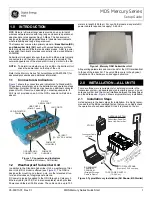
BTL5-A/C/E/G1_-M_ _ _ _-B/Z-NEX-S32/KA_ _
Micropulse Linear Transducer - Rod Style
8
english
Ignition Class "n"
7
Calibration procedure
7.1
Selecting calibration mode
System not running:
Depending on the application use
either Teach-in or manual adjust.
System running:
In special situations the online set-
ting mode may be used.
7.2
Teach-in
The factory-set null- and endpoints
will be replaced by the new null-
and endpoints. First move the mag-
net to the new null position, then to
the new end position, and press the
buttons to accept the correspond-
ing value.
➥
➥
➥
➥
➥
Section 8 Teach-in mode
1 2
1
2
Fig. 7-1: Calibration device
(shown on transducer)
= Button 2
gray
End
value
Accept new
end value
Accept new
null value
rising
Null
value
falling
before
after
2nd step: Move magnet to new end
position
1st step: Move magnet to new
null position
New stroke 100 %
before
after
Fig. 7-3: Teach-in procedure
1
/ 2
1
1
2
1
1
1
+ 2
1
+ 2
1
+ 2
2 +
1
2
2
2
Teach-in
Adjust
Null
point
End
point
Fig. 7-2: Selecting calibration mode
Buttons
disabled
Buttons
enabled
Null
point
End
point
Online-
setting
Null point
End point
Buttons
disabled
Buttons
enabled
Online-
setting
= Button 1
blue
Reset
Please note:
The calibration device is to be
attached to the connection end of
the transducer as shown in
➥
➥
➥
➥
➥
Fig. 7-1. Connect the trans-
ducer to the controller. To monitor
the calibration procedure, a dis-
play (controller or multimeter)
which displays the BTL voltage or
current levels is required. All set-
tings are done with a magnet
within the stroke area.
Please verify that the absolute
null- and endpoints are always
within the maximum and mini-
mum possible output values
(
➥
➥
➥
➥
➥
value table 8-1 on page 9).
Any desired magnet position
within the factory set nominal
stroke length can be assigned
with a null- or endpoint. Do not
however reverse the null- and
endpoints.
Once the calibration procedure is
concluded, the calibration device
can be removed to prevent acci-
dental changes and to store in a
safe place for the next use.
The examples shown in this hand-
book refer to the two versions
with 0 to 10 V and 4 to 20 mA
outputs. For all other versions the
corresponding values can be
found in the
➥
➥
➥
➥
➥
value table 8-1 on
page 9.
The buttons are automatically
disabled after approximately
10 minutes of non-use.
Advantages:
The display will always indicate
the current position value even
during the calibration procedure.
The last programmed values re-
main stored, regardless of
whether the programming mode
is ended manually by pressing the
buttons or automatically after
10 minutes.
















































